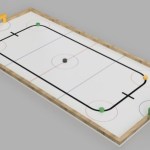The ASEE 2017 national competition was held in Columbus Ohio this year. The theme was Christopher Columbus’ travels through the Spanish islands. The goal was to build an autonomous robot which would carry dowels (barrels of goods) to six islands, drop a dowel off and pick up a dowel and then finally delivering the six collected dowels back into the large area representing Spain at the start of the track. The teams each get four trial runs in which all of the objectives have to be completed within a 90 second time frame. Lastly, the robot or robots for those using more than one, had a size constraint of 10″x10″x12″ for all robots combined during a trial run.

Disclaimer
Unfortunately I did not get to spend much time taking photos and videos as I was in charge of keeping score. I am also not getting around to positing the results until months after the competition so rather than provide a detailed run by run as I did in the ASEE TYESA Competition 2017 article I’m just going to provide you with the photos and videos I was able to capture with a little information on the results as well.
Competition Photos
Scenic Photos of Columbus
Here are some scenic photos of places we went and sites that we saw while in Columbus.
Competition Videos
As mentioned previously, I was not able to get videos of all of the runs partially because I was only recording on one track and also because some of the bots didn’t start or there were obstructions in the view of the camera. My only hope in presenting these videos is that they at least give future teams insights into how this year’s challenges were approached and which engineering ideas worked the best for a given robot. As I always say, engineering is about balance and there isn’t necessarily a general best approach. Depending on your robot’s design you have to choose the best approach in your case. Take a look at the videos and see if each team took the best approach for their robot, could one team’s approach have worked better on another team’s robot?
Use the playlist menu (upper left) to view the list of videos.
Results & Conclusion
Overall there was some fierce competition and as with every year, one subtle difference in a run can very easily bump your place in the running. Also, as with every year, the team with the most perfect runs took the plaques home, not the team with the fastest robot. The first place team had four perfect runs, second place had three, third place had two, and fourth place had one perfect run. I’ve tried to repeat over and over, you will never get in the top five without the most consistent robot. In this year’s competition, not one team would have benefited from making their robot any faster but many could have benefited from more consistency. For more on this, check out my other article How Important is Speed which shows the same data for multiple previous years’ competitions.
Of course, as I am affiliated with Monroe Community College, I would be remiss if I didn’t give a shout out to MCC for putting their name back in the top three. Here is an article posted in the MCC Student Tribune congratulating them as well.






